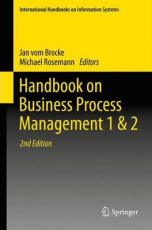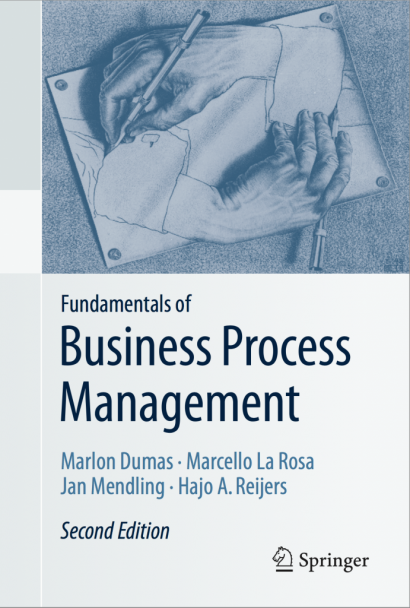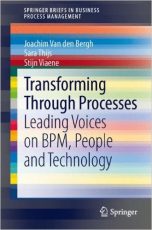About
Leading organizations
Includes cases from world’s leading organizations in various sectors
Global
Presents cases from a wide range of regions around the world
Real-world
The first book to present an extensive collection of real-world cases on Business Process Management
Overview
This Springer book is the second to present a rich selection of real-world cases on Business Process Management. It reports on best practices as well as lessons learned from organizations that have leveraged Business Process Management (BPM) to innovate and transform their business.
With economic and societal sectors of all kinds being challenged by disruptive changes due to digital technologies, in particular, this book shows how process thinking enables organizations to master digital innovation and transformation. The real-world cases presented in this book show how organizations leverage BPM capabilities both for exploitation and exploration in a digital world.
The book intends to bring together the experience of organizations using BPM. The focus is neither on academic case studies, nor on offerings from consulting companies. The intent is to learn from the experience organizations using BPM have made. That said, both academic institutions as well as consulting companies may well be involved in the case, but the case has to be developed from the perspective of the BPM-adopting company and the way BPM was used to solve contemporary organizational challenges.
The cases provide valuable examples for practice, as well as interesting cases for students. All case descriptions follow a unified schema making the case knowledge easily accessible to readers.
Table of Contents
Foreword
- by Martin Petry
Preface
- by Jan vom Brocke, Jan Mendling, and Michael Rosemann
Introduction
-
Jan vom Brocke, Jan Mendling, and Michael Rosemann: Planning and Scoping Business Process Management with the BPM Billboard
Cases on Process Technology and Automation
-
Jan Marek, Kurt Blümlein, and Charlotte Wehking: Process Automation at Generali CEE Holding: A Journey to Digitalization
-
Stefan Schönig, Andreas Ermer, and Stefan Jablonski: Sensor-Enabled Wearable Process Support in the Production Industry
-
Luise Pufahl, Bridie Ohlsson, Ingo Weber, Garrett Harper, and Emma Weston: Enabling Financing in Agricultural Supply Chains Through Blockchain
-
Fabian Ludacka, Jean Duell, and Philipp Waibel: Digital Transformation of Global Accounting at Deutsche Bahn Group: The Case of the TIM BPM Suite
-
Antonio Manuel Gutiérrez Fernández, Freddie Van Rijswijk, Christoph Ruhsam, Klaus Kogler, Anna Shadrina, and Gerhard Zucker: Tracking Energy Efficiency Performance at Clean Energy Solutions
-
Florian Pauker, Juergen Mangler, Stefanie Rinderle-Ma, and Matthias Ehrendorfer: Industry 4.0 Integration Assessment and Evolution at Methods
- Michael Rosemann: The NESTT – Rapid Process Redesign at Queensland University of Technology
- Amy Van Looy & Sabine Rotthier: Kiss the documents! How the City of Ghent digitizes its service processes
- José Ricardo Cereja, Flavia Maria Santoro, Elena Gorbacheva, Martin Matzner: Application of the Design Thinking Approach to Process Redesign at an Insurance Company in Brazil
- Thomas Karle, Kurt Teichenthaler: Collaborative BPM for Business Transformations in Telecommunications – The case of “3”
- Elisa Marengo, Patrick Dallasega, Marco Montali, Werner Nutt, Michael Reifer.: Process Management in Construction Expansion of the Bolzano Hospital
- Robert Andrews, Moe Wynn, Arthur H.M ter Hofstede, Jingxin Xu, Kylie Horton, Paul Taylor, Sue Plunkett-Cole : Exposing Insurance Claims Processing Impediments: Compulsory Third Party Insurance in Queensland
- Tom Thaler, Sabine Norek, Vittorio De Angelis, Dirk Maurer, Peter Fettke, Peter Loos: Mining the Usability of Process-Oriented Business Software – The Case of the ARIS Designer of Software AG
- Robert Andrews, Suriadi Suriadi, Moe Wynn, Arthur H.M. ter Hofstede, Sean Rothwell: Improving Patient Flows at St. Andrew’s War Memorial Hospital’s Emergency Department through Process Mining
Cases on Process Analysis and Monitoring
-
J. C. A. M. Buijs, R. F. M. Bergmans, and R. El Hasnaoui: Enabling Process Mining in Airbus Manufacturing
-
K. F. Canjels, M. S. V. Imkamp, T. A. E. J. Boymans, and R. J. B. Vanwersch: Improving the Arthrosis Care Process at Maastricht UMC+: Unraveling Complex and Noncomplex Cases by Data and Process Mining
-
Andreas Metzger, Johannes Franke, and Thomas Jansen: Ensemble Deep Learning for Proactive Terminal Process Management at the Port of Duisburg “duisport”
-
Marcus Dees, Massimiliano de Leoni, Wil M. P. van der Aalst, and Hajo A. Reijers: Accurate Predictions, Invalid Recommendations: Lessons Learned at the Dutch Social Security Institute UWV
-
Imesha Denagama Vitharanage, Denise Toman, Wasana Bandara, and Rehan Syed: Realizing the Benefits of Process Improvement: The Case of Queensland University of Technology
Cases on Governance and Strategic Alignment
-
Wasana Bandara, John C. Merideth, Angsana A. Techatassanasoontorn, Paul Mathiesen, and Dan O’Neill: Successful BPM Governance: Insights from Commonwealth Bank of Australia
-
Ahmad Alibabaei: On the Role of BPM Governance at “System Group”. The BPM Journey of an Iranian Software Solution Provider
-
Thomas Kuhn, Jenny Bruhin, and Tecwyn Hill: Making Processes Patient-Centric: Process Standardization and Automation in the Healthcare Sector at Hirslanden AG
-
Seyed Amir Bolboli, Ludger Hasenauer, and Cristina Cabanillas: BPM Adoption at the Industrial Services Provider Bilfinger
-
Klaus Cee, Iris Bruns, Andreas Schachermeier, and Lena Franziska Kaiser: Adoption of Globally Unified Process Standards: The Case of the Production Company Marabu
-
Angelo Corallo, Mariangela Lazoi, Manuela Marra, Lorenzo Quarta, Aurora Rimini, and Cesare Liaci: A Processes Reference Framework for the Creative and Cultural Industries. The Case of the Puglia Creativa Cluster
-
Elheme Azemi and Saimir Bala: Exploring BPM Adoption and Assessing the Strategic Alignment of Processes at Raiffeisen Bank Kosovo
-
Renata Gabryelczyk, Artur Grygorowicz, and Agnieszka Bitkowska: Developing Business Process Architecture at Poland’s Ministry of Finance. An Uneasy Journey Toward BPM
-
Konrad Schießl, Andreas Weigert, and Gunter Beitinger: Integrating Hoshin Kanri into Business Process Management: A Holistic Approach at Siemens Electronic Works Amberg
Who is Who
Case Description
Case Structure
All cases follow a unified structure that makes the relevant case knowledge easily accessible and transferrable to other contexts. Following the structure the chapters are short and sharp. The structure helps readers in finding the most interesting parts of the cases.
- Introduction – What is the story of the case? A brief narrative of the entire case informs readers by summarizing its key aspects.
- Situation faced – What was the initial problem that led to the action taken? The context of the case is specified concerning needs, constraints, incidents, and objectives.
- Action taken – What was done? What measures were undertaken, such as in regard to process redesign or process innovation? What methods and approaches were used?
- Results achieved – What effects resulted from the actions taken? Results could take the form of changes in performance measures and/or qualitative statements from employees, customers, and other business partners. To what degree were expectations met or not met?
- Lessons learned – What did the organization learn from the case? What can others learn? Lessons learned are grounded in the case and serve as example for others.
Frameworks
This book uses well-established BPM frameworks to characterize the cases it presents based on a shared language.
BPM Six Core Elements (Rosemann, vom Brocke, 2015):
The model helps to describe what actions an organization took to conduct BPM. It conceptualizes six BPM capability areas, namely: Strategic Alignment, Governance, Methods, Information Technology, People, and Culture. The key characteristic of the model is to enlarge the understanding of BPM from a mere technical concept towards a holistic management discipline. Click here for more material on the framework.
BPM Lifecycle-Modell (Dumas et al., 2013):
The model helps to structure the different tasks that are associated with BPM. It describes six major steps: process identification, process discovery, process analysis, process redesign, process implementation and process monitoring and controlling. The key characteristic of the model is to illlustrate how a BPM project or a BPM initiative can be organized towards arriving at an improved process. Click here for more material on the model.
BPM Context Framework (vom Brocke, Zelt, Schmiedel 2015):
The model helps to characterize a BPM initiative according to specific context factors, such as goal, process characteristics, organizational characteristics, and environmental characteristics. The key characteristic of the framework is to capture the situational nature of BPM. BPM needs to be aligned to the specific context of an organization and the BPM context framework helps to assess this context. Click here for more material on the framework.
Editors

Prof. Dr. Michael Rosemann

Prof. Dr. Jan Mendling

Prof. Dr. Jan vom Brocke
Jan vom Brocke is the Hilti Endowed Chair of Business Process Management and Director of the Institute of Information Systems. Jan has conducted over 300 studies, published in renowned outlets including MIT Sloan Management Review, Management Science, MIS Quarterly (MISQ), Journal of Management Information Systems (JMIS), Journal of Information Technology (JIT), European Journal of Information Systems (EJIS), and Information Systems Journal (ISJ). He has authored and edited over 30 books, including the International Handbook on Business Process Management, BPM – Driving Innovation in a Digital World, Green BPM: Toward the Sustainable Enterprise, and BPM Cases. Digital Transformation – Strategy, Processes and Execution. Jan is a globally recognized thought leader, recipient of over 20 international awards and he has been named Fellow of the Association for Information Systems. He is an invited speaker and trusted advisor on BPM serving many organizations around the world. See Jan`s website for more information.
Jan Mendling is the Einstein-Professor of Process Science with the Department of Computer Science at Humboldt-Universität zu Berlin, Germany. His research interests include various topics in the area of business process management and information systems. He has published more than 450 research papers and articles, among others in Management Information Systems Quarterly, ACM Transactions on Software Engineering and Methodology, IEEE Transactions on Software Engineering, Journal of the Association of Information Systems and Decision Support Systems. He is a department editor for Business and Information Systems Engineering, member of the board of the Austrian Society for Process Management (http://prozesse.at), one of the founders of the Berlin BPM Community of Practice (http://www.bpmb.de), organizer of several academic events on process management, and a member of the IEEE Task Force on Process Mining. He is co-author of the textbooks Fundamentals of Business Process Management, Second Edition, (http://fundamentals-of-bpm.org/) and Wirtschaftsinformatik, 12th Edition, (https://lehrbuch-wirtschaftsinformatik.org/), which are extensively used in information systems education.
Michael Rosemann is the Executive Director, Corporate Engagement, and Professor in Information Systems at the Queensland University of Technology and the Honorary Consul for the Federal Republic of Germany in South Queensland. Michael has published more than 250 refereed papers, including publications in renowned outlets, includ- ing MIS Quarterly (MISQ), European Journal of Informa- tion Systems (EJIS) and Information Systems. His books are available in five languages and he has conducted invited keynotes at international, academic and professional BPM conferences. Michael provides regular advice to executives on revenue resilience, innovation systems and process design. See Michael`s website for more information.
Editorial board
We are grateful for the support of colleagues and friends supporting this project on the editorial board of BPM Cases.
- Saimir Bala, WU Vienna
- Jörg Becker, University of Münster
- Cristina Cabanillas, WU Vienna
- Claudio Di Ciccio, WU Vienna
- Marlon Dumas, University of Tartu
- Maria Fay, University of Liechtenstein
- Roope Jaakonmäki, University of Liechtenstein
- Henrik Leopold, WU Vienna
- Mikael Lind, Viktoria Swedish ICT and Chalmers University of Technology
- Sonia Lippe-Dada, University of Liechtenstein
- Peter Loos, Saarland University
- Monika Malinova, WU Vienna
- Charles Møller, Aalborg University
- Michael zur Muehlen, Stevens Institute of Technology
- Hajo Reijers, VU University Amsterdam | Eindhoven University of Technology
- Maximilian Roeglinger, University of Bayreuth
- Andreas Rogge-Solti, WU Vienna
- Michael Rosemann, Queensland University of Technology
- Christoph Rosenkranz, University of Cologne
- Alexander Schmid, University of Liechtenstein
- Nadine Székely, University of Liechtenstein
- Matthias Tietz, University of Liechtenstein
- Peter Trkman, University of Ljubljana
- Sanja Tumbas, University of Liechtenstein
- Amy van Looy, Ghent University
- Stijn Viaene, Vlerick Business School
- Isabell Wohlgenannt, University of Liechtenstein
- Sarah Zelt, University of Liechtenstein
Please get in touch with us on any related matter.
Authors
|
|
|
Related Books

Handbook on Business Process Management

Fundamentals of Business Process Management



